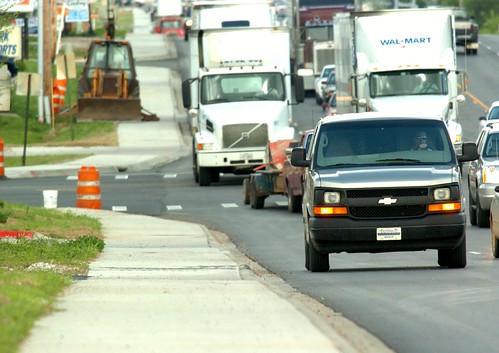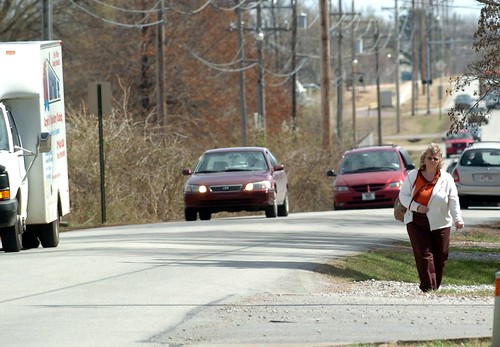
News
By Steve Davis, March 26, 2010
 |
| The administration's Partnership for Sustainable Communities testifies before Congress, representing Housing, Transportation, and the Environment. |
From the President down to the Secretary of Transportation, administration officials have spent the year vocally supporting a focus on livability from the federal government — doing what's in their power to encourage smarter, people-centric planning to create more great places to live where residents have numerous options for getting around and a high quality of life. Perhaps unsurprisingly in this polarized white-hot political era, there's been a backlash in Congress from some rural legislators.
But isn't livability really a quintessential small-town value? Shouldn't these legislators be the foremost advocates for the federal government encouraging states to repair their roads and bridges before building new ones, making walking and biking safer to boost mobility in places where transit isn't quite feasible and encouraging growth in historic small town Main Streets across America?
Bear with me for a personal story as I try to get to the bottom of that question. Part two continues today. Read part one here if you missed it.
--
 |
| Downtown Bentonville, Arkansas. |
When gas prices shot to historic levels in the summer of 2005 and following Hurricane Katrina later that year, many residents, especially in the fast-growing new parts of Bentonville, Arkansas, were stuck with few options other than to bear the pain at the pump, stay at home, work from home, or take as few trips as possible.
But for me and my wife and many others living in the older part of the city in those weeks with astronomical gas prices, a pretty normal life was still possible, even while trying to cut back driving significantly to save money. Several weekends in a row, we parked our cars entirely, and managed to do our grocery shopping, go to church, visit friends, or listen to bluegrass in the square on a Friday night without having to get in either of our two cars. We walked 5 minutes to the grocery store. We biked to Walmart a handful of times — receiving many strange looks in the process. We went to eat at a new restaurant on the square. We went hiking on a short trail in the woods right on the edge of downtown. We went to the library.
Sounds pretty "livable," right?
These sorts of fond memories about life in Bentonville are the ones rattling around in my brain when legislators from largely rural states question whether or not "livability" is a value that translates to our small towns, cities and rural areas.
Where are values like livability and quality of life more resonant if not in small towns like Bentonville? Other small towns and cities aren't that different. Even in largely rural states like Wyoming or Montana, the majority of residents are still generally concentrated around urbanized areas, the old town square, or the former railroad depot in a pattern similar to Bentonville.
When Transportation Secretary Ray Lahood talks about livability as the desire people have for a range of transportation options, the freedom to own less than 2 or 3 cars, a high quality of life with ample green space, biking or walking paths, and shopping, restaurants or health care located nearby, he's describing the very lifestyle of many residents of rural areas or small towns have, or the lifestyle many of them would like to have.
Former Meridian, Mississippi Mayor John Robert Smith of Transportation for America and Reconnecting America testified last week in Washington on the transportation challenges facing our small towns and rural areas. While the issues facing these areas may be different than large urban areas, residents in these places want many of the same things — good transit networks, options for getting around, safe streets, bridges that don’t fall down and highways that aren’t cracked and potholed.
 |
| Would you walk here? Originally uploaded by Transportation for America |
| State highway and main thoroughfare in Bentonville. AHTD standard sidewalk. |
Transportation challenges facing small town America are not of congestion but of access – long commutes, volatile energy prices, and shifting demographics all impact the prosperity of these communities. Many small towns and rural areas lack the financial resources, planning capacity, or authority to implement solutions to their transportation needs. A bold new policy is needed at the federal level to meet those needs.
Current federal transportation policy for a place like Bentonville doesn't really work. They can try and get the state DOT on board with what they want to do, with varying levels of success. For example, the City had an ordinance to build usable sidewalks on all new and reconstructed roads, making the streets safe as possible to encourage safe walking and biking. The Arkansas DOT at the time did sidewalks as a total afterthought — sticking a sidewalk right smack next to 5 lanes of traffic on a 45 or 55 mph highway (pictured).
Federal transportation policy is clearly in need of an overhaul when cities get money from Congress they didn't ask for, to do something they don't necessarily want to do.
 |
| Will the future 8th street have sidewalks, or be another 5-lane speedway? |
When the last six-year transportation bill (SAFETEA-LU) passed in 2005, the City found out along with everyone else that Rep. John Boozman had secured a $37 million earmark for the widening of a city street and connection to the interstate. Walmart had gone straight to Rep. Boozman to lobby for the money, and the City found out when our newspaper did. The two-lane road runs through the very heart of town, connecting the Walmart HQ to their IT department next to the interstate, but it also runs straight through the street grid of local walkable streets. It clearly needs sidewalks (pictured), but the City is now on the hook for the contract and the project, and with money coming through the state DOT, will the City be able to build the walkable, safe, complete street they envision?
As Streetsblog noted in Mayor Smith's testimony, small towns and cities could really benefit from the kinds of innovative federal grants that would allow them to make long range plans to improve livability and steer transportation and land use investments into those parts of town that have the infrastructure now to support the growth. Growth slowed in Bentonville over the last few years, and now they're left with subdivisions southwest of town that are scattered about, have no grocery store nearby, and are generally disconnected from the city.
People who live in classic American small towns like Bentonville know a thing or two about livability. There's nothing "livable" about being stuck in your subdivision that got built too far from town, work or school when gas prices get too high. Nor is it "livable" to have the federal government incentivizing (through money to the State DOT) the widening of highways into the county to encourage more sprawl outside of town even as the city is clamoring for more investment inside of it.
Some in Congress seem to think that "livability" is some sort of urban hoodwinking of rural America. They need look no further than the sidewalks and town squares of their state's small towns to see the truth.
Call it what you want, but it looks like livability to me.
Administration photo from DOT Fastlane blog, all other photos by Stephen Lee Davis.
Related News

© 2025 Smart Growth America. All rights reserved
Site By3Lane Marketing








